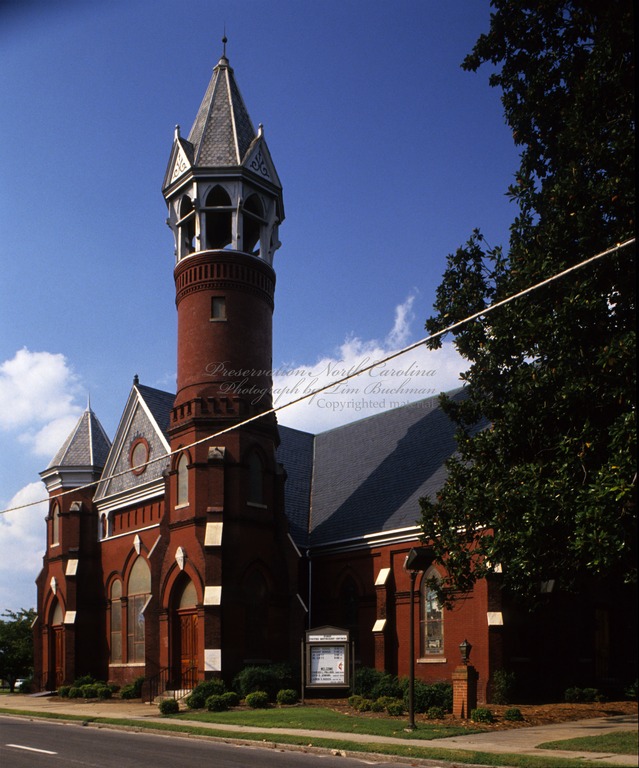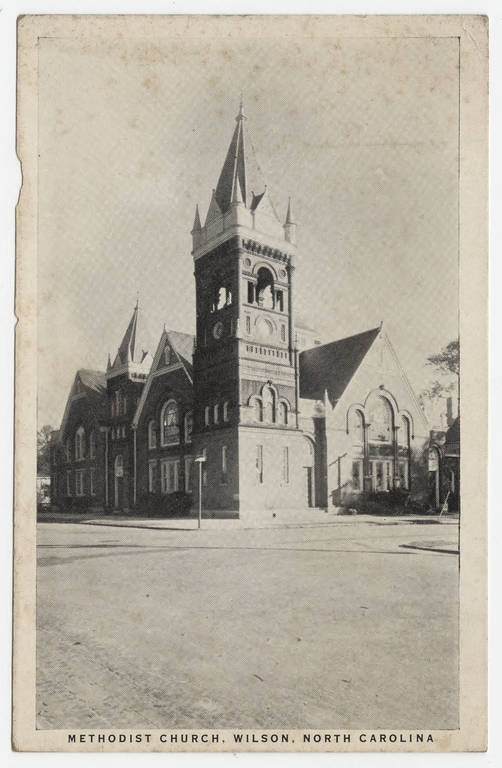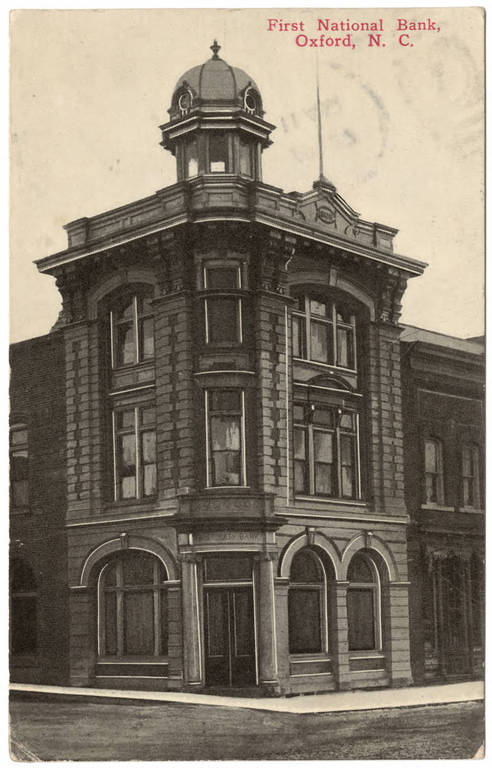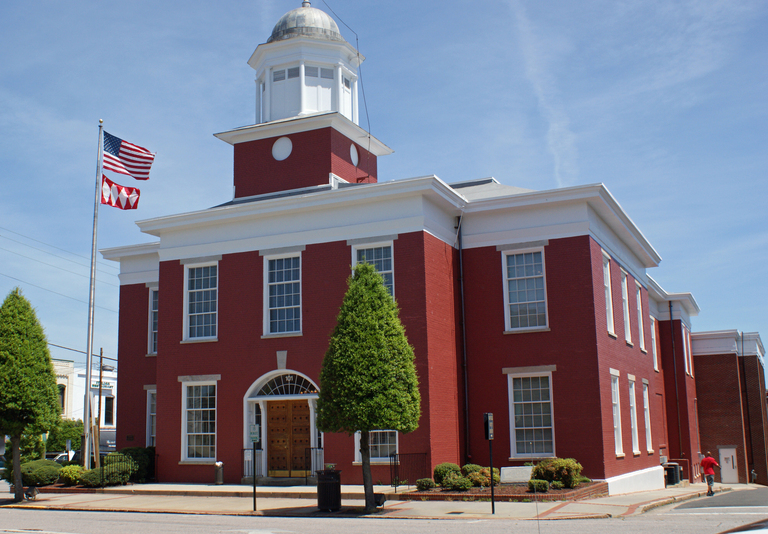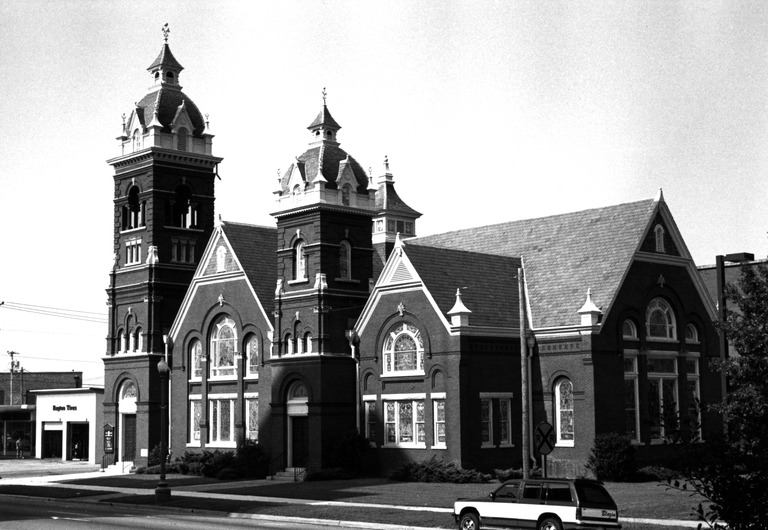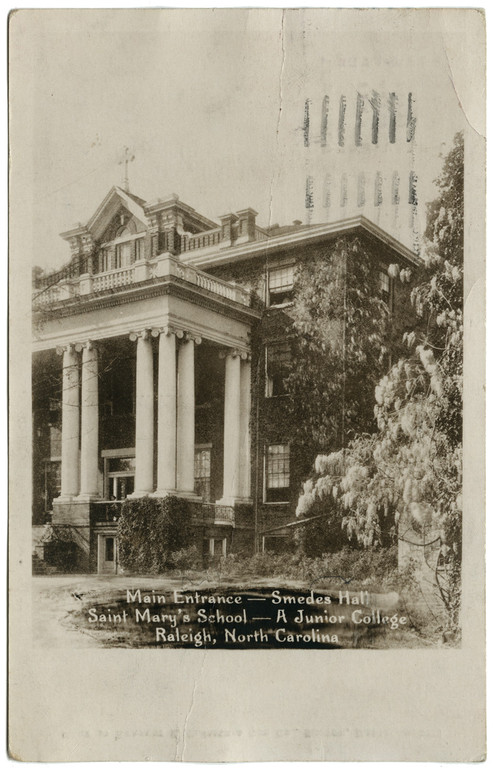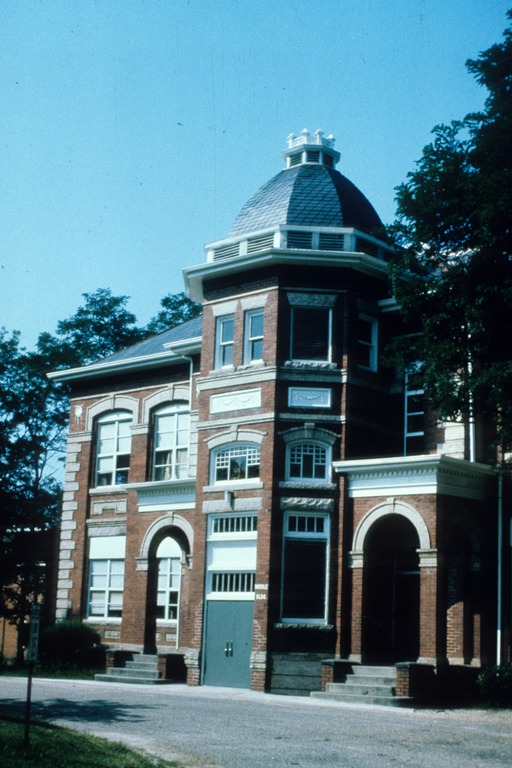Hartge, Charles E. (1865-1918)
Variant Name(s):
Carl Emil Hartge
Birthplace:
Hamburg, Germany
Residences:
- Tarboro, North Carolina
- Washington, North Carolina
- Raleigh, North Carolina
Trades:
- Architect
Building Types:
Styles & Forms:
Colonial Revival; Gothic Revival; Romanesque Revival
Charles E. Hartge (September 1, 1865-October 25, 1918), a German-born architect originally named Carl Emil Hartge, designed many churches, schools, and other buildings in central and eastern North Carolina around the turn of the 20th century. After coming to the United States in 1882, he settled in Tarboro by 1888, when he applied for American citizenship, and by 1890 had an established architectural practice there. He married Effie, a woman from Wayne County, and they had three daughters.
In his application for a passport in 1895 (in advance of a family trip back to Germany), Hartge stated that he was born in Hamburg, Germany, and had emigrated to the United States on the Steamer “Gelbert” from Hamburg in 1882. He had lived “mostly in North Carolina” since arriving in the country. For the passport application, he used the name Carl Emil Hartge, probably the original spelling, though he had been using the Anglicized name Charles regularly.
From Tarboro he wrote in 1890 a revealing letter to J. W. Root of Chicago, an officer of the national American Institute of Architects. He noted that that he had just completed Tarboro City Hall and some residences and had a substantial (unnamed) church underway. He was supervising “the more complicated buildings in this vicinity, that is build them from the jump.”
Hartge’s 1890 letterhead indicates his versatility in a time and place that rewarded such activity: “Office of Charles E. Hartge, Architect& Builder/ Manufacturers Agent for All Kinds of Seasoned Lumber, Sash, Doors, Blinds, Mouldings, Brackets,/ also Galvinized Iron Cornices, Finials, Crestings, &c.” He offered “plans and Specifications Carefully Prepared for All Kinds of buildings at Reasonable Prices. Also Buildings Superintended.” He also promised “Contracts taken for All Kinds of Buildings. Estimates Furnished on Application.” His letter to Root gave the rationale for his flexibility: he preferred to “only make plans, but this country does such a little of work, that I could not earn the Salt, if I was only to draw plans, etc.”
Outside of Tarboro, one of Hartge’s earliest known buildings was mentioned in the Manufacturers’ Record in 1891, which identified him as the architect of the Atlantic Coastline Depot in Rocky Mount, not far from Tarboro; this may refer to the 1-story predecessor of the present brick depot of 1903 and later. The ACL was then building new facilities in towns where he worked—Tarboro, Kinston, Plymouth, and Washington, North Carolina—but his involvement in planning those depots is not established.
Some of his early projects involved the remodeling of prominent antebellum buildings. These included additions (1891) to the Granville County Courthouse in Oxford; a substantial rebuilding (1893) of Grace Episcopal Church in Plymouth—the original Gothic Revival structure by architect Richard Upjohn having been damaged in the Civil War bombardment of the town; and remodeling (1893) of St. Peter’s Episcopal Church in Washington.
The Hartges moved to Washington, where the 1900 United States Census found them residing as a family including Charles, Effie, and their three daughters. Hartge’s work in Washington may have included railroad buildings and, especially, the numerous brick commercial buildings erected there after a downtown fire in 1900. His most imposing work in Washington is the First Methodist Church, where the cornerstone announces, “Designed and erected by C. E. Hartge, 1899.” It is one of the state’s prime examples of the auditorium plan church, executed with superb craftsmanship in the rich brickwork of pressed brick and molded and corbelled bricks, Gothic Revival openings, and especially complex and robust forms including a multi-stage tower. Whether Hartge’s German background had any effect on such compositions is unknown.
Hartge evidently found success among Methodist congregations. Marked similarities with the Washington church suggest that he might have planned the Oxford Methodist Church, in the town where he expanded the courthouse. For the First Methodist Church in Wilson, he produced an auditorium plan with round-arched openings and multiple towers and gables. Again, similarities between this church and the Queen Street United Methodist Church in Kinston are strong enough to suggest his hand in that striking edifice. Hartge, like other architects of his day, probably drew upon popular church design books such as Franklin Kidder’s Churches and Chapels (1895) and others that illustrated churches of similar type.
By 1901 Hartge opened an office in Raleigh, and he soon moved there with his family. In Raleigh he gained several commissions, including Episcopal church work. His Church of the Good Shepherd (1899-1914) is a soberly imposing Gothic Revival design in rough-cut granite with magnificent interiors; a spire planned for one of the towers was never built. At St. Mary’s School, an Episcopal school for girls and young women, he remodeled and expanded the antebellum Smedes Hall by adding a tall portico, dormers, and wings. This was one of several early-20th century buildings where Hartge combined red brick with bold, sometimes eclectic classical detail. Amid the boom in public school building, he produced the red brick Wakelon School (1908-1909), one of the most substantial and elaborate public schools of its day in the county. He likewise used red brick and classical trim in one of his last known works, the Wake County Home, sponsored by the county.
Throughout his career, Hartge took a strong interest in the professional status of the architect, an important issue at a time when the profession was striving for recognition and greater professionalism in the state. In the long letter he wrote in 1890 to AIA officer J. W. Root of Chicago, he lamented the local situation and asked for guidance and rules on proper architectural fees, the accepted quantity of architectural drawings, and membership in the AIA. When the opportunity arose some years later, he participated in organizing the profession in North Carolina. In 1907 he was probably the “H. L. Hartge” reported in the Wilmington Star as having been elected to the board of the North Carolina Architectural Association. In 1913, when architect Hill C. Linthicum reported to Glenn Brown, national AIA secretary, that the North Carolina chapter of the AIA had been “duly organized” in Greensboro, Hartge was among the initial local chapter members. Hartge was one of the first licensed architects in North Carolina. His license certificate, issued in 1915, was #19 in the official registration book of the North Carolina Board of Architecture, one of the early group of men who were licensed in the state based on their having been in professional practice prior to the licensing act of 1915.
Hartge died in Raleigh in 1918; he may have been one of the many victims of the influenza epidemic. His widow, Effie, continued to reside in Raleigh for several years.
- Catherine W. Bishir, Charlotte V. Brown, Carl R. Lounsbury, and Ernest H. Wood III, Architects and Builders in North Carolina: A History of the Practice of Building (1990).
- Catherine W. Bishir and Michael T. Southern, A Guide to the Historic Architecture of Eastern North Carolina (1996).
- Catherine W. Bishir and Michael T. Southern, A Guide to the Historic Architecture of Piedmont North Carolina (2003).
- Charlotte Vestal Brown Papers, Special Collections Research Center, North Carolina State University Libraries, Raleigh, North Carolina.
- Edmund Hoyt Harding, Saint Peters Parish, Washington, North Carolina: A Record of the Century, 1822-1922 (1922).
- C. David Jackson and Charlotte V. Brown, History of the North Carolina Chapter of the American Institute of Architects, 1913-1998 (1998).
- North Carolina Board of Architecture, Record Book 1915-1992, microfilmed by North Carolina State Archives, Raleigh, North Carolina.
- Kate Ohno and Robert C. Bainbridge, Wilson, North Carolina, Historic Buildings Inventory (1980).
- J. W. Root to Charles E. Hartge, Tarboro, North Carolina, 1890, American Institute of Architects MSS Box 4: S 13, 1890-1891, American Institute of Architect Archives, Washington, D.C.
Atlantic Coastline Passenger Depot
Contributors:Charles E. Hartge, architectDates:1891
Location:Rocky Mount, Nash CountyStreet Address:Main St., Rocky Mount, NC
Status:No longer standing
Type:Transportation
Note:In 1891, the Manufacturers’ Record cited Hartge as architect of the depot in Rocky Mount; it was evidently the predecessor of the present imposing depot.
Church of the Good Shepherd
Contributors:Charles E. Hartge, architect; M. A. Moser, contractorDates:1904-1914
Location:Raleigh, Wake CountyStreet Address:125 Hillsborough St., Raleigh, NC
Status:Standing
Type:Religious
Images Published In:Linda L. Harris and Mary Ann Lee, An Architectural and Historical Inventory of Raleigh, North Carolina (1978).
First Methodist Church
Contributors:Charles E. Hartge, architectDates:1899
Location:Washington, Beaufort CountyStreet Address:304 W. 2nd St., Washington, NC
Status:Standing
Type:Religious
Images Published In:Catherine W. Bishir, North Carolina Architecture (1990).
Catherine W. Bishir and Michael T. Southern, A Guide to the Historic Architecture of Eastern North Carolina (1996).
First Methodist Church
Contributors:Charles E. Hartge, architectDates:1900-1904
Location:Wilson, Wilson CountyStreet Address:Corner of Green St. and Tarboro St., Wilson, NC
Status:No longer standing
Type:Religious
Images Published In:Kate Ohno and Robert C. Bainbridge, Wilson, North Carolina, Historic Buildings Inventory (1980).
First National Bank Building
Contributors:Charles E. Hartge, architectDates:1908
Location:Oxford, Granville CountyStreet Address:Oxford, NC
Status:Unknown
Type:Commercial
Note:The Manufacturers’ Record cited Hartge as architect of the First National Bank Building in Oxford in 1908. The building has not been further identified.
Grace Episcopal Church
Contributors:Charles E. Hartge, architect; Richard Upjohn, architect; Richard Upjohn and Company, architectsDates:1860-1861; 1892-1893 [rebuilt]
Location:Plymouth, Washington CountyStreet Address:107 Madison St., Plymouth, NC
Status:Standing
Type:Religious
Images Published In:Catherine W. Bishir and Michael T. Southern, A Guide to the Historic Architecture of Eastern North Carolina (1996).
Note:During the Civil War, much of Washington’s architecture was damaged by bombardments. Grace Church, designed by Richard Upjohn and Company, was severely weakened. In the 1890s architect Charles E. Hartge rebuilt most of the church, but he is believed to have saved and incorporated Upjohn’s tower and apse into the church.
Granville County Courthouse
Contributors:Charles E. Hartge, architectDates:1891 [addition]
Location:Oxford, Granville CountyStreet Address:Oxford, NC
Status:Standing
Type:Public
Images Published In:Marvin A. Brown and Andrew J. Carlson, Heritage and Homesteads: The History and Architecture of Granville County, North Carolina (1988).
Jamestown Public School
Contributors:A. F. Brooks and William Baker Hunt, contractors; Charles E. Hartge, architectDates:1915
Location:Jamestown, Guilford CountyStreet Address:Jamestown, NC
Status:Standing
Type:Educational
Masonic Temple and Opera House
Contributors:Charles E. Hartge, architectDates:1904
Location:Rocky Mount, Nash CountyStreet Address:Rocky Mount, NC
Status:Unknown
Type:Fraternal
Note:The Manufacturers’ Record (May 5, 1904) cited Hartge as architect of a Masonic temple and opera house in Rocky Mount. Both are probably lost; another Masonic Temple was built in Rocky Mount several years later.
Oxford Methodist Church
Contributors:Charles E. Hartge, stylistically attributed architectDates:1895-1905
Location:Oxford, Granville CountyStreet Address:College St. and McClannahan St., Oxford, NC
Status:Standing
Type:Religious
Images Published In:Marvin A. Brown and Andrew J. Carlson, Heritage and Homesteads: The History and Architecture of Granville County, North Carolina (1988).
Queen Street United Methodist Church
Contributors:Charles E. Hartge, stylistically attributed architectDates:Ca. 1910
Location:Kinston, Lenoir CountyStreet Address:500 N. Queen St., Kinston, NC
Status:Standing
Type:Religious
Images Published In:M. Ruth Little, Coastal Plain and Fancy: The Historic Architecture of Lenoir County and Kinston, North Carolina (1998).
Note:The Queen Street Methodist Church is attributed to Hartge based on its strong similarities to his Methodist church in Wilson.
Rogers House
Contributors:Charles E. Hartge, architectDates:Ca. 1903 [remodeled]
Location:Oxford, Granville CountyStreet Address:115 E. Front St., Oxford, NC
Status:Standing
Type:Residential
Images Published In:Marvin A. Brown and Andrew J. Carlson, Heritage and Homesteads: The History and Architecture of Granville County, North Carolina (1988).
Smedes Hall
Contributors:William Drummond, builder (1835-1837); Samuel Hancock, brickmaker (1835-1837); Charles E. Hartge, architect (1909); Thomas A. Waitt, builder (1835-1837)Variant Name(s):Main Building
Dates:1835-1837; 1909 [addition]
Location:Raleigh, Wake CountyStreet Address:Hillsborough St. at St. Mary’s St., St. Mary’s School, Raleigh, NC
Status:Standing
Type:Educational
Images Published In:Linda L. Harris and Mary Ann Lee, An Architectural and Historical Inventory of Raleigh, North Carolina (1978).
Elizabeth C. Waugh, North Carolina’s Capital, Raleigh (1967).Note:The illustration shows Smedes Hall as remodeled by Charles E. Hartge.
St. Peter's Episcopal Church
Contributors:Charles E. Hartge, architectDates:1864; 1868-1873; 1893 [remodeled]
Location:Washington, Beaufort CountyStreet Address:NE corner of Bonner St. and E. Main St., Washington, NC
Status:Standing
Type:Religious
Images Published In:Edmund Hoyt Harding, Saint Peters Parish, Washington, North Carolina: A Record of the Century, 1822-1922 (1922).
Tarboro City Hall
Contributors:Charles E. Hartge, architectDates:Ca. 1890
Location:Tarboro, Edgecombe CountyStreet Address:Main St., Tarboro, NC
Status:No longer standing
Type:Public
Note:The photograph shows the Tarboro City Hall in the background on the right.
Wake County Home
Contributors:Charles E. Hartge, architect; M. A. Moser, contractorDates:1913
Location:Raleigh, Wake CountyStreet Address:W. Whitaker Mill Rd., Raleigh, NC
Status:Standing
Type:Public
Images Published In:Norman D. Anderson and B. T. Fowler, Raleigh: North Carolina’s Capital City on Postcards (1996, 2000, 2002).
Wakelon School
Contributors:Charles E. Hartge, architectDates:1908-1909
Location:Zebulon, Wake CountyStreet Address:1001 N. Arendell St., Zebulon, NC
Status:Standing
Type:Educational
Images Published In:Norman D. Anderson and B. T. Fowler, Raleigh: North Carolina’s Capital City on Postcards (1996, 2000, 2002).
Catherine W. Bishir and Michael T. Southern, A Guide to the Historic Architecture of Piedmont North Carolina (2003).
Kelly A. Lally, The Historic Architecture of Wake County, North Carolina (1994).Note:The Wakelon School suffered from a fire later in the 20th century but was rebuilt in a simpler version of the original.

